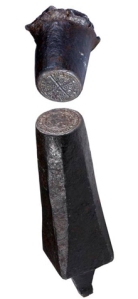Since I already wrote a post on the debasement of coinage during Henry’s reign, I thought I’d look up a little about coining methods, techniques and laws regarding minting during the time. At a time when there was no paper money, and certainly no plastic money or electronic money, mints were used exclusively for making coins from different metals.
Coins were produced in Roman Britain, but an English mint was only set up around 650. The mints were held by many different individuals as businesses, but eventually, by the reign of Henry, they had all consolidated into one single mint in London. Considering that the mint was held by the king, it was just added to the royal treasury. It produced copper, silver or gold coins in the name of the King and received a portion of the metal as seigniorage. Seigniorage was a kind of royalty paid to the mint for services rendered.
One major and positive effect of the Henrican Reformation was the closure of ecclesiastical mint of Canterbury, York and Durham where coins were manufactured in the name of the King, but revenues of seigniorage was sent to Rome. While some historians dispute that the dissolution was not the reason for the closure of these ecclesiastical mints, but lack of bullion, the fact remains that these were closed down during the major reformation years, with Canterbury closing down in 1537, Durham in 1541, and York in 1542. And in 1544, the Royal Mint became centralised and run directly under the King. So, thanks to Henry, another bit of good done!
The Royal Mint was already established in the 13th century, but now it became the only mint authorised to mint coins for use. This ensured that the King could ensure standardisation of the coinage. It also ensured that the revenues of minting coins were made over to the royal treasury. And most importantly, it ensured that the higher rates of seigniorage were now directly made over to the government.
The rates of seigniorage were 4.6 percent for each silver and 1.1 percent for each gold coin minted. But during the Great Debasement, it rose to dizzying heights with around 50 % for silver and anything between 3 to 10 percent for each gold coin minted.
The traditional method of striking coins was still in vogue in Henrican England. Check out the picture above. These were the dies used to make the coins. The lower one was called a pike and the upper one, a trussel. They both contained the images that had to be carved on to the coins. The required metal was heated strong enough to soften it. Then it was hammered into a certain thinness required for the coin. A blank piece of metal was then placed on the pike and the trussel is placed over it, and then hammered down with a hammer, thus producing impressions on both sides. Then the coin was set to cool, and voila! Ready for shopping! Of course there was a lengthy procedure to it, but this was basically how it was done.
And now we come to the scourge of the economy – counterfeiters. Though there would not have been large scale counterfeiting taking place due to lack of technology, enough was happening for the royal authorities to be alert and mete out harsh punishments for the crime. In Henry’s reign, counterfeiting was redefined as a capital crime, and anyone indulging in forgeries was generally hanged. By precedence, they could also have had their ears cut off, or boiled to death, but hanging was the commonly used punishment for forgers.
That Henry VIII debased the coinage for his war with France is well-known, but how far do we know how much profit was made by these debasements? Well, there seems to be no consensus on this matter. While one source states that the amount received in profits is 1,014,500 pounds, another directly contradicts it and says the amount was approximately 227,378 pounds – a very valid reason for more research to be undertaken in this area.
And I’ll leave you with a curious incident recorded in the Royal Mint archives, the tale of William Foxley, Sleeper in the Mint.
William Foxley, a maker of melting pots, was discovered asleep at his post and remained asleep for fourteen days. All attempts to wake him failed. Even pricking him with needles and inflicting small burns did not cause him to stir. Word of the spectacle became so widespread that even Henry VIII went to examine him personally, but he too could offer no explanation. When Foxley finally awoke, it seemed to him as if he had slept only one night. He appeared to have suffered no ill effects from the incident and is recorded in the Chapel Register as having died forty years later.
Sources
Christopher E. Challis: A New History of the Royal Mint
Christopher E. Challis: The Debasement of the Coinage, 1542-1551, The Economic History Review
Arthur J. Rolnick, François R. Velde & Warren E. Weber: The Debasement Puzzle: An Essay on Medieval Monetary History
Royal Mint Museum website
Royal Mint website

A very good article. I liked the tale of William Foxley – the man who slept for 14 days. He obviously wasn’t very ill as he died so many years later.
Thanks, Caroll. I thought it was sweet Henry went to visit the man himself and try to fix him.
I wish I could sleep for fourteen days! 😉
Great post, as always!
Don’t we all? 😉